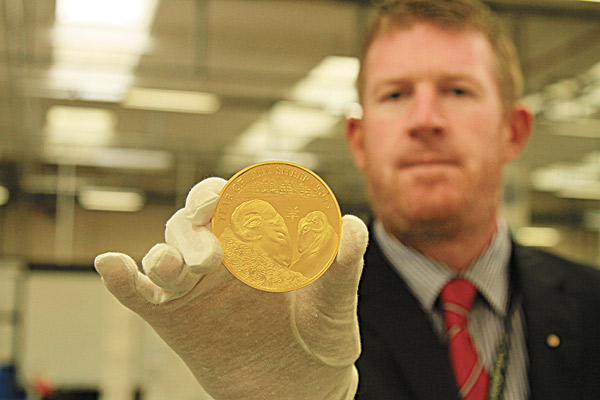Sheep worth their weight in silver and gold for 2015
China Daily, October 13, 2014 Adjust font size:
|
|
|
An employee at the Royal Mint shows the lunar coin with the Chinese zodiac's sheep sign. [China Daily] |
The Royal Mint, UK's official coin manufacturer, has launched its second legal tender lunar coin to woo wealthy Chinese collectors, riding on high sales of its first lunar coin a year ago.
To coincide with 2015, the Year of the Sheep, the new coin features the animal, the second of the Chinese zodiac.
Fergus Feeney, the mint's program director, says it will continue with the coins every year to cover all 12 animals. The series is among the top five commemorative coins for the mint, he says.
"The lunar coins are one of our most important commemorative coins not just in terms of revenue, but it is building a foundation for the future and serving our customers."
The mint decided to launch the series after the success of its commemorative coins for the London Olympics in 2012, for which China was the largest market, even bigger than the domestic market in the UK. To reach out to its Chinese buyers, the mint has also established an account on weibo, the Chinese answer to Twitter.
Such popularity has encouraged the mint to produce a China-focused coin, hence the Year of the Horse commemorative coin launched at the end of last year. Feeney says the horse coins achieved tremendous sales, which encouraged his team to work on the Year-of-the-Sheep coin with great enthusiasm.
Many of the lunar coins are sold to Chinese living in the UK, as well as coin collectors in China. In China, the Royal Mint sells coins through local partners, one of which is China Gold Coin, with which it has had ties for more than 10 years.
The sheep coin, like the horse coin, is designed by Wuon-Gean Ho, a British Chinese artist whose understanding of Chinese and British cultures allowed her to create a design attractive to both Chinese and international coin collectors.
The coin's foreground features two sheep facing each other, their heads curled close to their bodies, and eyes full of energy. Their wool is presented in neat curly patterns and their horns are big and strong.
The sheep in the design are of the Swaledale breed, a hardy animal named after a Yorkshire valley and well suited to the often harsh British climate.
Swaledales are known for their smooth, curled horns, seen on both ewes and rams, which contrast with the swirls of the sheep's wool coat, Ho says.
The background of the face of the coin features a woodland, with a few trees clearly visible. The trees are in the shape of the Chinese character yang, which means sheep. In the middle of the face of the coin is also a distinctly inscribed yang character.
Ho, who was born and grew up in Oxford of Malaysian and Singaporean parents, graduated with a bachelor's in art history and as a veterinary surgeon at Cambridge University before taking up a Japanese government scholarship in 1998 to study woodblock printmaking in Japan.
Even though she grew up in the UK, she says she is fascinated by Asian art and has traveled across Asia, visiting countries including China, Thailand, Malaysia and Singapore.
"I think the Asian way of creating things and looking at things is very much embedded in my landscapes. When you go to a country and breathe the air and eat the food, it changes your outlook on life."
As a former vet, she has become familiar with sheep, particularly when they gave birth.
"In that role, I sometimes had to wait for hours for the birth to happen, and during this time I sat and watched the sheep, observing its physical characteristics and unique attributes."
That experience made it relatively easy to make a design featuring sheep, she says.
One of Ho's original designs was a ewe and its lamb, which looks very different from the finished design. She was originally going to inscribe the yang character on the forehead of the ewe but felt this had religious connotations and may look "too Western".
Designing the sheep and transforming it onto the coin required some adjustments, one being to make the sheeps' eyes bigger, as they normally appear much smaller when depicted on a coin, she says.
Ho says one challenge in the design process was to work with a circular design, because she normally produces square-shaped drawings. Another challenge was to make sure the trees in the background show up well, and that the character yang is legible, so seven trees she drew originally had to be reduced to four.
Last year, Ho's equine design featured a powerful leaping horse with a big tail high in the wind.
The sheep coin design is featured on a number of different coins, made from either 999.9 fine gold or 999 fine silver. The range includes gold and silver coins in five ounce, one ounce and tenth of an ounce.
The range also includes kilo coins, both in gold and silver and weighing one kilogram each, which are the first lunar kilo coins introduced, and are presented in elegant Chinese-inspired packaging.
The Royal Mint is 1,100 years old, but since 2010 it has operated as Royal Mint Ltd, a company that has an exclusive contract with HM Treasury to supply all coins for Britain. It is fully owned by the UK Treasury.
Each coin the mint produces is given a set mintage, which is the maximum number of coins to be produced, and determines how collectable the coin is.
Feeney says after the mintage is set, 40 percent of this is made immediately, and as sales increase, more are made, until total mintage is achieved.
The year-of-the-horse coin has almost sold out, he says, and he hopes the year-of-the-sheep coin will sell just as well.


